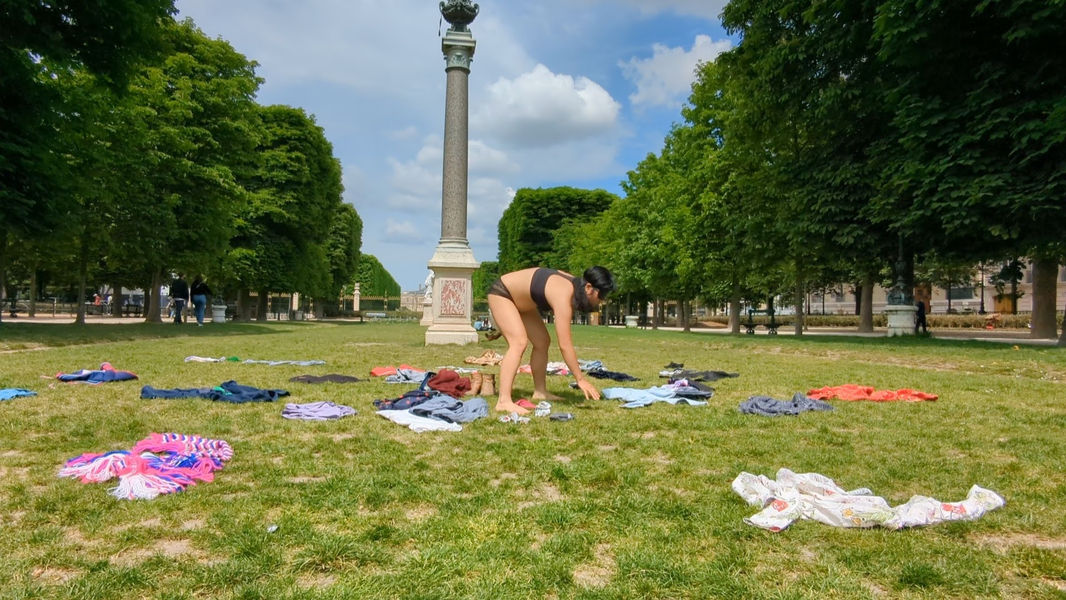SHE DRESSES ME IN HA'THAO
In this piece, I am blindfolded, and have to find the traditional clothes of my tribe among other many clothes. Once I find them, I’ll try to put them on properly. I can take off the blindfold and leave the scene only when it’s finish.
Born as a “Pangcah” in Tafalong Tribe in eastern Taiwan, we put on this traditional “Ha’thao” when attending important rituals, it’s hence an important object to mark the identity of Pangcah.
The dress is combined with lots of different elements. Each part of the dress has a special way and order to wear. It is- it seems- so complicated, that since I was a kid, it was my grandmother who dressed me.
I brought this dress along to Europe for a theatre play, but the plan changed, and I never got the chance to wear it.
At some point I was nostalgic, and take “Ha’thao” out of my luggage case.
I suddenly remembered that I can’t really put the dress on as early as my grandmother did. When I tried to do it- clumsily- and closed my eyes trying to remember- I found out that it wasn’t just me putting on Ha’thao, it was also a replication of my grandmother’s memories, movements, thoughts, and visions.
During putting on Ha’thao, I am me, and also my grandmother.
It is me, and also my grandmother, that dress/shape/present me as a Pangcah in front of the world- a different world I’m about to see and to be a part of, after being a Pangcah.
ELLE M'HABILLE EN HA'THAO
Dans cette pièce expérimentale, j'ai les yeux bandés, et je dois retrouver les vêtements traditionnels de ma tribu parmi de nombreux autres vêtements. Une fois que je les aurai trouvés, j'essaierai de les mettre correctement. Je peux enlever le bandeau et quitter la scène seulement quand c'est fini.
Né en tant que "Pangcah" dans la tribu Tafalong dans l'est de Taiwan, nous revêtons ce "Ha'thao" traditionnel lors de la participation à des rituels importants, c'est donc un objet important pour marquer l'identité de Pangcah.
La robe est combinée avec beaucoup d'éléments différents. Chaque partie de la robe a une manière et un ordre particuliers à porter. C'est - paraît-il - tellement compliqué, que depuis que je suis gosse, c'est ma grand-mère qui m'habille.
J'ai apporté cette robe en Europe pour une pièce de théâtre, mais le plan a changé et je n'ai jamais eu la chance de la porter.
À un moment donné, j'étais nostalgique et j'ai sorti "Ha'thao" de ma valise.
Je me suis soudain souvenue que je ne pouvais pas vraiment mettre la robe aussi tôt que ma grand-mère le faisait. Quand j'ai essayé de le faire - maladroitement - et que j'ai fermé les yeux en essayant de me souvenir - j'ai découvert que ce n'était pas seulement moi qui mettais Ha'thao, c'était aussi une réplique des souvenirs, des mouvements, des pensées et des visions de ma grand-mère.
Pendant la mise sur Ha'thao, je suis moi, et aussi ma grand-mère.
C'est moi, et aussi ma grand-mère, qui m'habille/forme/me présente comme une Pangcah devant le monde, et une fois devenu Pangcah, je revois le monde différemment.
她為我穿HA'THAO
在這個作品中,我矇著眼,必須在眾多的衣物之中,找到我所屬部落的傳統服飾,並且依序穿上。當我認為已穿妥服飾之後,才能脫下矇眼布,離開現場。
我出身於台灣原住民阿美族的太巴塱部落。從小在部落參與祭典,都必須換上這套正式服飾,是標誌太巴塱人身份的重要物件。服飾分為許多部份,細節繁瑣且複雜,因此,從小到大,都是阿嬤為我穿上。
為了另一齣作品,我將這件服飾帶來歐洲,最後卻沒有用上。
某個時刻,我非常想家。
當我將這套衣服從行李箱拿出來時,才發現我難以熟練地自行將這套服飾穿戴完成。
然而,在我笨拙地嘗試穿上,閉上眼睛回想穿戴方式的時刻,我發現,這些順序與身體的姿勢,正是在複製阿嬤留在我身體的記憶與視線——在穿戴這些衣服時,我是我,卻也是我的阿嬤,在這些穿脫的過程中,讓Ihot Sinlay Cihek以「太巴塱人」的身份在公眾面前現身。
而當我成為太巴塱人之後,脫離了祖母在這套服飾與我身體上留下的痕跡,我所看到的世界、身處的世界,或許也將有所不同。



